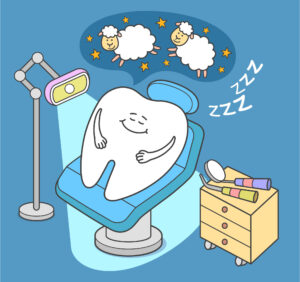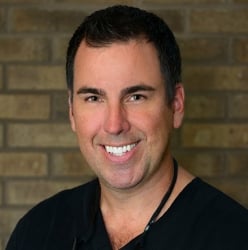Sedation dentistry exists to reduce discomfort and anxiety before and during oral surgery and other dental procedures. Although many people have heard of or used “laughing gas” while getting crowns or fillings, dental sedation is divided into different types.
Sedation is the process of using drugs to suppress a patient’s central nervous system (CNS), making them less aware of their surroundings and what is happening. Dentists often use sedation in conjunction with some anesthetics, but the two are not the same. The purpose of sedation is to produce a calming effect, whereas anesthetics manage pain. For example, a patient anxious about getting a novocaine shot before a filling might request laughing gas to relax and feel less stressed about the shot in the gums and the cavity filling.
Table of Contents
- Overall Benefits of Dental Sedation
- Inhaled Minimal Sedation
- Oral Sedation Dentistry
- Conscious IV Sedation
- General Anesthesia Deep IV Sedation
Overall Benefits of Dental Sedation
Many patients experience dental anxiety. Because this fear can prevent some people from getting proper oral health care, sedation is important in relieving their worries and reducing their avoidance of the dentist.
In particular, sedation dentistry can benefit people who have:
- A great deal of dental work to complete
- Dental anxiety
- Low tolerance for pain
- Trouble sitting still
- Strong gag reflexes
- Sensitive teeth
- Difficulty responding to or cooperating with the dentist during a procedure
- Complex medical conditions
Inhaled Minimal Sedation
With inhaled minimal sedation, the patient breathes in a mixture of nitrous oxide (“laughing gas”) and oxygen through a nose mask. This option may be ideal for patients who undergo routine procedures like cavity fillings and wish to be more comfortable.
During laughing gas sedation, the dentist places a small mask on the patient’s nose and asks them to breathe deeply. The patient will start to feel the effects within a few minutes. While sedated, the patient is awake but experiences relaxation and perhaps slight tingling in the arms or legs.
Benefits
Laughing gas sedation takes effect quickly, and it’s a generally safe and effective method for people with gag reflex problems. Also, the gas wears off fairly quickly once the patient stops breathing it, which allows them to drive home after the procedure.
Disadvantages
Laughing gas sedation might not be strong enough to alleviate some patients’ anxiety. In such cases, the dentist might administer laughing gas on top of oral sedation.
Oral Sedation Dentistry
With oral sedation dentistry (also called “oral conscious sedation”), the patient typically takes prescribed medication, usually benzodiazepine (e.g., Halcion, Valium), the night before the procedure, and they take another dose about an hour beforehand and bring another dose to the appointment. The doctor determines if the in-office dose is necessary before it is administered. Similar to laughing gas sedation, oral sedation dentistry deeply relaxes patients while allowing them to stay awake. However, most remember little to nothing after their appointment.
Oral sedation can range from minimal to moderate, depending on the pill dosage. Some patients under moderate sedation might fall asleep during their procedure, but the dentist is usually able to wake them up by nudging gently. The dentist might need to monitor the patient’s vital signs, depending on their medical history.
Benefits
Oral sedation dentistry may be a more viable option for fearful patients because it doesn’t involve needles. Also, patients are still awake enough to respond to the dentist’s requests or directives, and most can maintain their cardiovascular functioning without intervention during treatment. Finally, oral sedation is a relatively inexpensive method compared to conscious IV sedation or general anesthesia.
Disadvantages
The biggest disadvantage is that the oral drugs require going through the stomach to take effect. This may take time (more or less depending on patient) and their affects can be less predictable than IV drugs. Additionally, patients must arrange for alternative transportation to and from the dentist’s office. While they might remain sleepy hours after the procedure, the effects of sedation usually wear off the next day. Another disadvantage to oral sedation is that it might not be suitable for patients with a history of chronic drug use or patients regularly taking sleeping pills.
Conscious IV Sedation
Conscious intravenous (IV) sedation, or moderate sedation, involves injecting the sedative into a vein. The most common drugs administered for conscious IV sedation are Versed and Fentanyl. Patients undergoing conscious IV sedation dentistry are not aware of their surroundings and will not likely remember the procedure afterward.
Benefits
Conscious IV sedation takes effect almost immediately. Also, the dentist can adjust the dosage throughout the procedure, depending on how the patient responds to the sedative. Because the patient never completely loses consciousness, the dentist can still wake them up if they need to give them instructions. Although patients under this type of sedation are in an extreme state of relaxation, they don’t need assistance in breathing or maintaining their cardiovascular function.
Disadvantages
As with oral sedation, conscious IV sedation dentistry relaxes patients to the extent that they cannot drive themselves home after their appointment. Also, this type of sedation can be expensive, and not all insurance plans cover it. Some patients may feel drowsy for an extended period of time and some may even experience nausea.
General Anesthesia Deep IV Sedation

Although dentists often use GA for procedures like dental implant surgery and bone grafting, it is not as common a method as some might believe. Patients need to be in a specialized dental practice or hospital to receive GA. An anesthesiologist or nurse anesthetist must be present to deliver the sedative and monitor the patient’s heart rate, breathing, and other vital signs.
Benefits
General anesthesia dentistry is appropriate for oral surgery and prolonged procedures that would be too traumatic for patients to remember. It’s sometimes the most suitable option for patients who are too fearful or anxious for other types of sedation. If a patient is nervous enough to refuse to have the procedure unless they’re asleep for it, the dentist might opt for combining sedation with GA.
Older patient and patients with significant health history also benefit greatly from GA. Older patients and patients very sensitive to medication greatly benefit form the use of a very short acting GA medication such as Propofol. This allows them to recover very quickly and leave the office safely (still requiring a driver). Health compromised patients benefit from GA due to the ease of access via IV to administer emergency drugs and the additional medical doctor in the procedure (the anesthesiologist).
Some patients with intellectual disabilities might have a heightened fear that prevents them from cooperating under other forms of sedation. In addition, people with other special needs, such as mental illness or autism, often cannot relax or be compliant and, therefore, are not suitable candidates for sedation without general anesthesia.
Disadvantages
One of the most significant drawbacks of deep sedation is the cost. The cost is high due to the need for an anesthesiologist and nurse anesthetist. In some instances, deep sedation may result in the patient being too sedated to cooperate with the dentist. This is generally controlled by carefully titrating the medication during the procedure. Dentistry performed with this level of sedation is truly a specialized and requires an experienced team of professionals.
General anesthesia dentistry also poses health risks to some patients, such as those who have obstructive sleep apnea or are obese. Regardless of their health or risk factors, all patients should talk to their dentist about the health risks and the potential complications of GA.
- Dental Implant Pros and Cons - August 26, 2023
- Receding Gums Stages - August 12, 2023
- When Is It Too Late for Gum Grafting? - July 8, 2023


